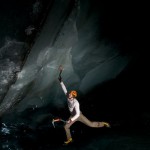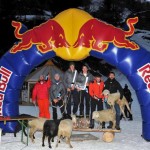 Ines Ines
Papert from Germany wins the first stage of the Ice Climbing World Cup
in Daone ahead of Anna Torretta from Italy and Stephanie Maureau from
France. Harry Berger from Austria and Samuel Anthamatten from
Switzerland tie for first place in the men's competition, Herbert
Klammer from Italy placet third.
WOMEN'S FINAL
Things
were going to be extremely tough today, and the first women's route
made this all to clear. 12 finalists, 4 had to bid their farewell –
this was the law of the KO final! And the battle started right from the
outset., from those very first meters that lead to the stalactite. Many
had their fare share of difficulties getting passed this first crux,
from Buchmann to Torretta, from Papert to Maureau. Then there was the
dry tooling section followed by a hint of ice which led to the long
traverse left onto the hanging drips and the top, The tension was
palpable. And the sub-zero temperature madet hings even harder.
As
a result Barbara Zwerger, the first of three Italians, was forced to
re-start three times before finally making a nice run third time
roundŠ Fiona Murray lost all hope immediatly after the first
stalactite, Mariam Filipova dropped her ice axe, Kirsten Buchmann
climbed high and started the move across onto the hanging drips. The
Russians Maria Shabalina and Marina Rashitova lost their ticket to
success battling it out on the dry tooling section. But
Stèphanie Maureau from France, after an incredible arm twist on
the first drip, accelerated and, after a determined fight, managed to
bring herself into a safe zone for the next round. Nataliya Kulikova,
the small, tenacious Russian, managed a similar feat, only just. While
Jenny Lavarda started well but touched out of bounds and was stopped by
the judges – a shame, because she'd climbed past all the hard sections.
Anna Torretta, as mentioned previously, ran into trouble on the first
stalactite but soon saw the light and, after this “false start”,
climbed quickly, risking moves without making mistakes – her fantastic
race ended on the penultimate drip and in safe qualification for the
next round. Only Petra Muller from Switzerland climbed better, as did
the usual, unshakable and highly capable Ines Papert. This meant that
Fiona Murray, Maria Shabalina, Jenny Lavarda and Barbara Zwerger failed
to qualify for the next round – Zwerger in particular was unfortunate
as she finished joint-equal with Kulikova but was excluded due to her
inferior Open results. These are the rules and they state clearly that
if athletes place joint equal then the results of the previous round
are takien into consideration. We weren't to know it yet, but as the
competition evolved this rule was going to become a determining
factorŠ but there was no time to sit back and think because the
next round had already begun.
 For For
the final eight remaining, the great roof was to become the key to the
last challenge.. The name of the game remained the same: 4
eliminations, 4 qualifiers. The traverse across the roof was arduous
and after an elegant exit across the drip finished up the dry tooling
panel. The Russian athletes comprised of Kulikova, Filipova and
Rashitova got lost in the meanders of the roof, some dropping axes, the
others simply pumping out. The battle through this horizontal roof was
a great one and the route fantastic. Buchmann's elegant ballet proved
the case, and she was the first to make headway on the dry tooling
section before being brought to a stop due to an out-of-bounds foot
placement. Maureau's determination was great too, and she was truly on
top form today. Torretta and Papert produced two outstanding
performances to reach the top, much to the crowd's delight.
It
was spectacular: Anna Torretta was fast and sure of herself like never
before, inviting the crowd to cheer her on as she cleared the lip of
the roof. Ines Papert was perfect as usual, and incredibly fast – a
rocket, one and a half minutes faster than the Italian. Although time
wasn't a determining factor here, apart from the maximum time allowed,
Papert's speed was indicative of how strong she is at the moment. But
ice is a fickle element, you never know what might happenŠ Petra
Muller's surprise exclusion from the final underlined just this, and
one of the favorites for victory saw her tiutle chances slip away in an
instant (the time it took for her axe to fall to the ground) half-way
through the roof.
The time had come for the true final, for the
third route, the all-important one which decided who was to win and who
wasn't. The final four were Anna Torretta, Stèphanie Maureau,
Kirsten Buchmann and Ines Papert. The (heinous and perfect) route
setters had prepared an extremely long route up the entire spider, the
longest of all. What counted here was how much strength the athletes
had left, how much they would manage to pull out from those hidden
reserves. Maureau started off first and fought incredibly high to just
beneath the final dry tooling panel. Buchmann set off next, elegant as
always but this time round less strong than usualŠ she fell
half-way through the overhang, clearly spent. Climbing on home ground
expectations were understandably high for Anna Torretta; the crowd
wanted a top and she wanted it even more. It was great to see her climb
smoothly, wave to the crowd and then fight up the two dry tooling holds
to reach the top. Hers was a fantastic competition! . But Ines Papert
was already at the starting blocks and she climbed smoothly,
consistently, without hesitation, meter after meter with apparent ease.
And obviously she reached the top!
For the second year running
Papert is the undisputed queen of difficulty in the Valle di Daone Ice
Maser. Anna Torretta had to make do with a beautiful second place
because, despite having topped out on the second and third route just
like Papert, she made less headway on the first route in the final (do
you remember – if athletes are joint equal the previous results are
taken into consideration). Stèphanie Maureau placed third, while
Kirsten Buchmann finished fourth. It was a great competition with
plenty of exciting moments such as the final tops, and plenty of
smiles, like those of Anna and Ines, the two friends and rivals, once
again up against each other in competitions.
 MEN'S FINAL MEN'S FINAL
Things
should never be taken for granted. Those who, after the Women's Final,
expected the Men's Final to be just as difficult, had to think again.
The 12 male finalists were offered a more climbable first route, or
rather, one which was more technical than powerful. Numerous athletes
topped out on a line which highlighted how beautiful dry tooling can
be, but resulted in many joint-equals. Hannes Pfeifhoferr started the
day off and just missed the top by failing to clip the chain in time,
while Bubu Bole reached the final holds without any difficulties
whatsoever, climbing quickly and aggressively. Just when the crowd was
beginning to take things for granted Markus Bendler was stopped for his
out-of-bounds foot placement. But this was to become the round of
endless tops and so, one after the other, all competitors reached the
abseil chain. Diego Mabboni, Mario Prinoth (classy style), Herbert
Klammer (machine-like power), Albert Leichtfried and Evgeny
Kryvosheytsev (speedy gonzalez) all topped out, meaning that 9 of the
finalists had qualified for the next round with full marks.
But
the competition held more surprises in store, such as young Samuel
Anthamatten's incredible “invention”: a giant leap from one ice patch
to the next which enabled him to avoid the dry tooling section
altogether. Samuel is extraordinarily crazy, and extraordinarily gifted
and electrifying: the crowd loved him and his thunderous style! The
other surprise during this first round came from none other than Harry
Berger himself, who fell low down on the first route. Luckily for the
Austrian he was still well within the toprope section and so he was
allowed to start again – as fast as lightening – to make up for lost
time, to reach a top and save a competition which seemed all but lost.
Fantastic! What's more, according to the rules this fall had no penalty
points whatsoever. And so the first stage came to an end after the
formality tops of Simon Anthamatten and Simon Wandeler, meaning that
Prinoth, Klammer, Mabboni, Leichtfried, Berger, the Anthamatten
brothers, Wandeler and Kryvosheytsev all qualified for the next round.
Those who didn't were Markus Bendler, Hannes Pfeifhoferr and Bubu Bole
who, despite today's top, was penalised for his inferior results in
yesterday's Open.
 Just Just
like for the women's final, the men's second exclusion round was the
large roof, this time though with the extremely overhanging dry tooling
start. Albert Leichtfried set off first, climbing strongly to the lip
of the roof. Local Diego Mabboni showed immediatly that the top was
possible by only just missing it as he was beaten to clipping the chain
not by the route itself but by the relentless clock. A few seconds were
all that was needed… Mario Prinoth fell as he climbed from the lip
onto the dry tooling section: his axe ripped off the first, tiny
artificial hold. Nothing and no one could stop Herbert Klammer who
chugged to the top like a train. And nothing and no one could stop
Harald Berger who, climbing in his usual impeccable manner, topped out.
Just like the incredible elve Samuel Anthamatten who, climbing fast as
lightening, sent one figure-of-four after the other to reach the chain.
There was just one question on everyone's lips: how do you manage to
bring these athletes down and, above all, how do you separate them?
This question became increasingly more important as the next two
athletes topped out: excellent Simon Wandeler, one of the most elegant
climbers in Daone today, and Simon Anthamatten, certainly as strong and
imaginative as his younger brother Samuel. The result: 5 athletes had
topped climbed cleanly through the incredible roof, all 5 were
perfectly joint equal. And they could have been joined by Evgeny
Kryvosheytsev, had he not committed a foul by pressing the lip of the
roof with his hand… Evgeny, Prinoth and Mabboni failed to qualify
therefore. And the competition continued.
The third and final
round now awaited Klammer, Berger, the Anthamatten brothers and
Wandler. And this last route was a long route, the longest of all, the
most overhaning, spectacular and acrobatic past three hanging drips.
The idea was simple: by now the competitors are tired, at last they'll
have met there match. What's more, the outing is so long they'll have
to race to keep within the time limit. We thought we'd see some true
difficulty. That's what we thought, because sine the outset these
certainties were destined to become serious doubt, above all when
Klammer stopped climbing only when he ran out of holds to pull on. His
top was matched by that of Berger, increasingly precise, decisive and
concentrated. And then it was his turn, the turn of the small,
impossible and unstoppable Samuel Anthamathen who, climbing at
breakneck speed, swung, hit, and dynoed to the top. Suddenly it looked
like this round was to become a dummy, had Simon Anthamathen and Simon
Wandler reached the top, too. But things were to turn out differently,
though only just – Wandler ran out of time just beneath chain. So at
the end of mammoth competition a super-final was needed to separate
these three athletes who, after 6 routes and 6 tops, were all there,
tied for first place.
 This This
is how the “massacre” super-final came to life. Or rather, two more
routes, the passport to paradise and the end. The first climbed through
the roof and was made harder by the route setters by minimising the
zones, while the second climbed up the marathon column to the top of
the structure, and this too was rendered a few grades harder by
reducing the zones. A little spice was added to the show by reducing
the rest time between one climb and the next: 6 minutes only, just to
make sure that the athletes had no time to recuperate… Well, Herbert
“machine” Klammer showed that all of this was to be of no avail by
immediately topping out on the powerful first route, and he was
emulated by the warrior Samuel Anthamatten and “prince” Harry Berger.
Another three tops! Joint-equal once again.
How strong can these
climbers be? But there was no time to think because Klammer was already
beneath the finishing holds of the last route… but time ran out.
Incredible Samuel Anthamatten accelerated right from the start and,
chopping axes and crampons produced a genial and unthinkable climb to
top out! Unstoppable! And to cap it all, just to show that more
couldn't be achieved, he climbed out onto the top of the structure,
took out some slack and leaped off into the void. Just like in the
early days of the Rock Master… and the crowd went wild. But Berger
was already out of the starting blocks, and he produced a perfect
performance, naturally right to the very top. And so, after 8 routes
all climbed cleanly, Harald Berger and Samuel Anthamatten were
announced the joint winners of the first stage of the UIAA Climbing Ice
World Cup 2006. Herbet Klammer, the strong one, placed third.
What
more can be said at the end of this marathon run here in Daone? You've
probably guessed by now that it was a great competition with great
athletes. Let us add hat there were many, many people who came to
watch. And let us state that the future of ice climbing competitions
have seen the light here in Daone. And that these athletes have proven
to be mature enough for pure difficulties (and a spectacle) that was
unimaginable up until only yesterday. Only the future knows what lies
in store. Naturally here in Daone, on the craziest, most beautiful and
incredible ice structure in the world. . Those who have never seen ice
climbing competitions before
See you here in Daone in 2007 for another great Ice Master!
Siehe auch:
www.daoneicemaster.it
www.planetmountain.com
|
 Ines
Ines

![[VIDEO] Bolting and Rebolting Sikati Cave Kalymnos Bolting and Rebolting Sikati Cave Kalymnos (c) Klara Stein photography](https://www.climbing.de/wp-content/uploads/2024/06/youtube_6YGqFQG-ugc-218x150.jpg)

![[VIDEO] Bouldern in den Wäldern von Fontainebleau Bouldern in den Wäldern von Fontainebleau (c) Bayerischer Rundfunk](https://www.climbing.de/wp-content/uploads/2024/06/youtube_Fy9khlZqouw-218x150.jpg)
![[VIDEO] Alex Huber: Vom klassischen Bergsteiger zur ersten 9a+ der Welt Alex Huber: Vom klassischen Bergsteiger zur ersten 9a+ der Welt (c) juraclimbs](https://www.climbing.de/wp-content/uploads/2024/06/youtube_Fw54csp7A_I-218x150.jpg)
![[VIDEO] Alexander Megos: What about the triceps? Alexander Megos: What about the triceps? (c) Alexander Megos](https://www.climbing.de/wp-content/uploads/2024/05/youtube-zBW1fp9bh3s-218x150.jpg)
![[VIDEO] Adam Ondra on “Bon Voyage” E12 (9a) Adam Ondra on "Bon Voyage" E12 (9a) (c) Adam Ondra](https://www.climbing.de/wp-content/uploads/2024/05/youtube_ji4At78H5Ys-218x150.jpg)

















